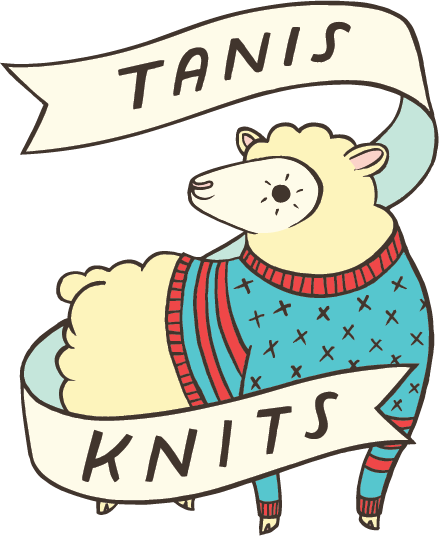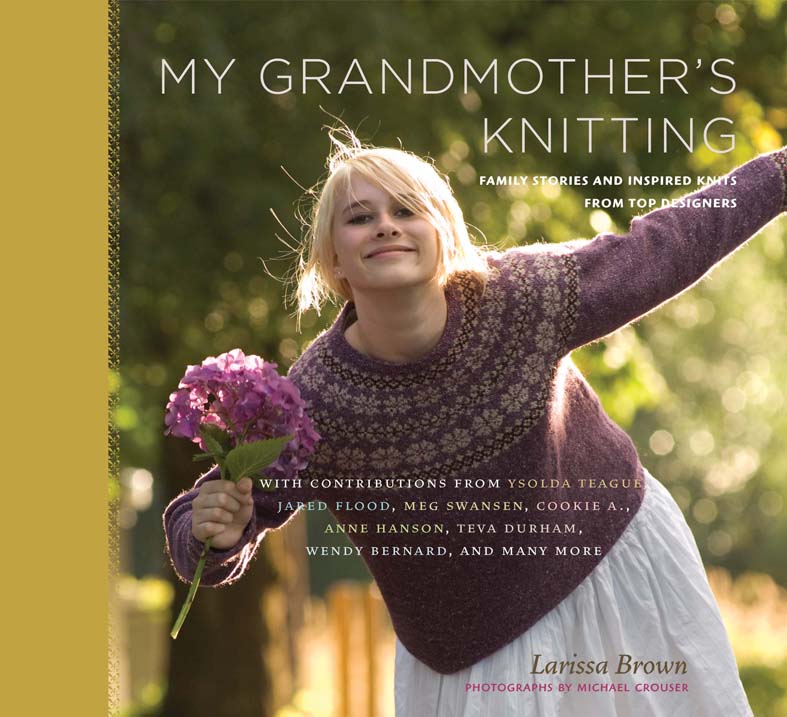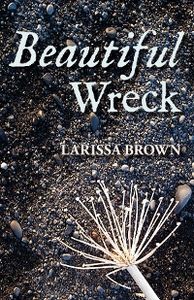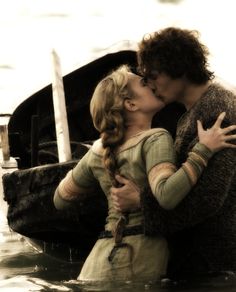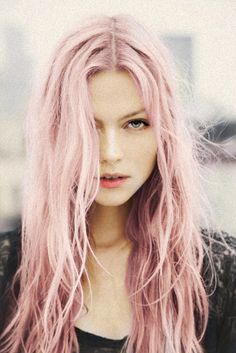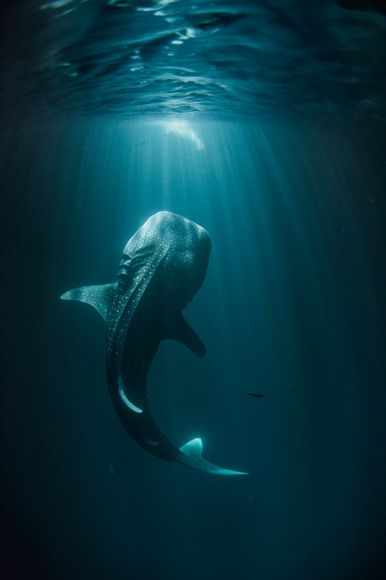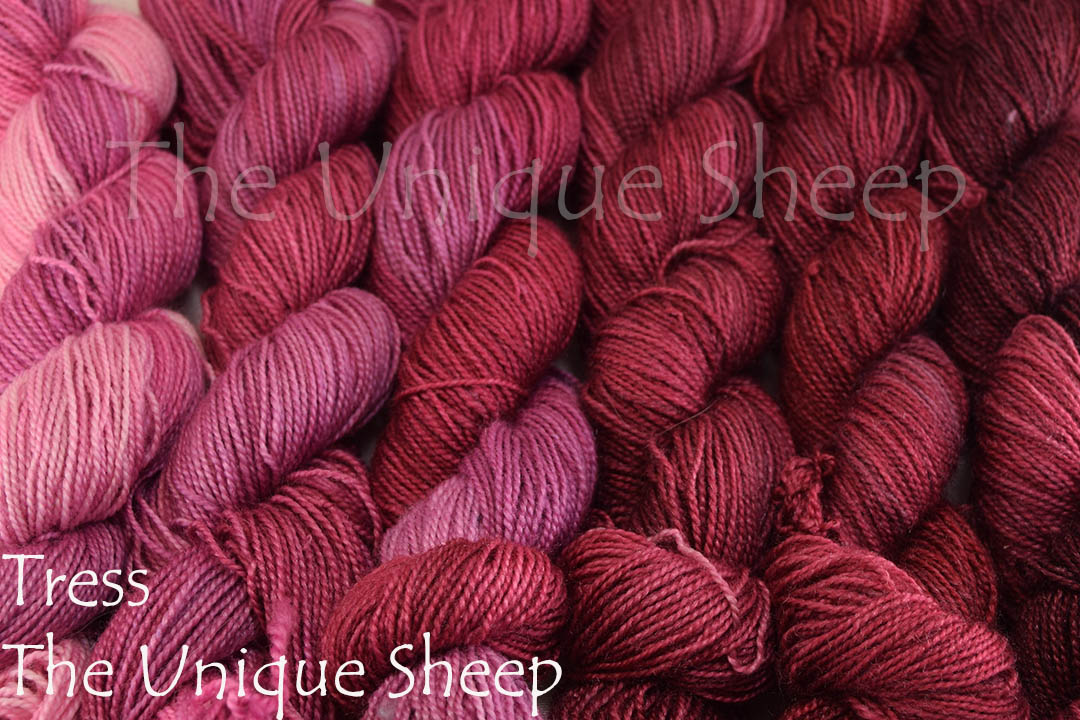I'm excited to share a new author interview with you, dear readers. Larissa Brown is the author of knitting book favorites Knitalong and My Grandmother’s Knitting, but did you know she's a novelist as well? Her novel, Beautiful Wreck, is one I've read multiple times and her latest novella, Tress (which I've also read, both available here) came out very recently. Larissa had a project in my first book, Knit Local, and I'm glad we've kept in touch over the years. Larissa was kind enough to sit down and answer a few questions I posed to her...
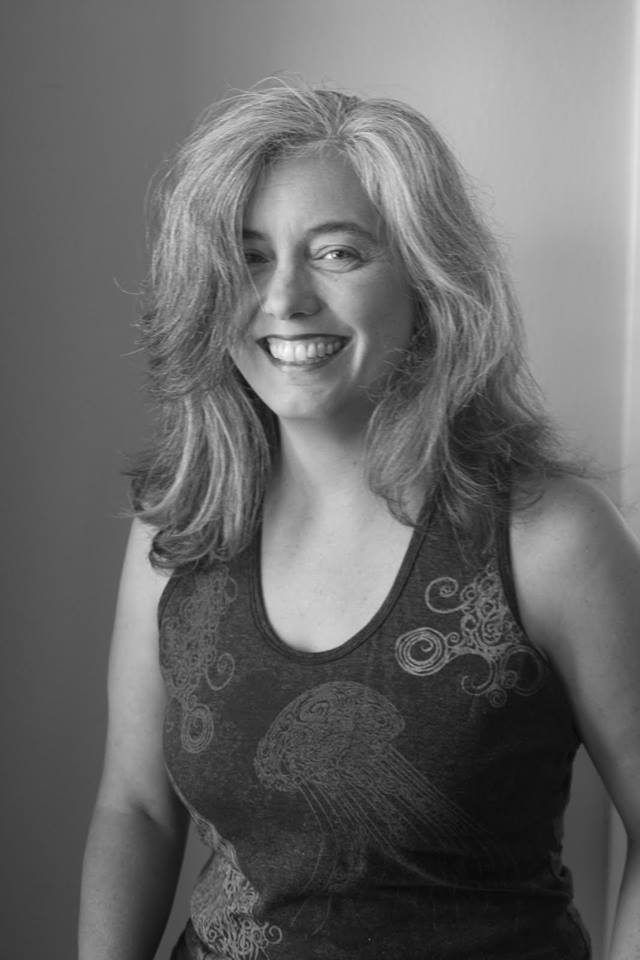
Tanis Gray (TG): Not everyone knows you write both knitting books and novels. They are so different in both style and subject matter. Which do you like writing more and why?
Larissa Brown (LB): I feel like I’ve told the whole world that I write fiction! How could they not know? ;)
It’s true, I write both and I love them both for different reasons. I’m more excited about my fiction right now, but the process is so painful, I’m not sure I’d say I “like” writing it. It reminds me of a conversation I had with a friend about sitting around with family on Thanksgiving. He said, “I’ll really love having these memories later, but I’m not going to like making them.” There are days when I feel that way about writing fiction. I love having written it.
(I think fellow author and knitter Rachael Herron has written about feeling the same way, and I’ve heard the same from other writers. Writing fiction seems like something you want to do so bad on the days when you can’t. Then you find yourself doing practically anything to avoid it.)
My craft books – Knitalong and My Grandmother’s Knitting – are heavy on writing as compared to most design-focused books. (Note: The best parts of Knitalong were written by my husband and co-author Martin.) Like you did with Knit Local, I included stories that go along with and enrich the designs. I really love to write about the social and creative aspects of knitting, and besides my books, I’ve published essays and articles in Jane Austen Knits and knitty.com.
You’re right that the writing styles are very different. But when I look closely, I can see that it’s all inspired by the same things. For two years, it was all Vikings all the time. I wrote Beautiful Wreck and also published two collections of knitting designs: My Viking Love Song and Shieldmaiden Knits.
Most recently, I wrote an essay about Knitting & The Art of Fairytales. I spent hours looking at first editions of gorgeous books and immersing myself in my own children’s books to write that essay. When it got cut from the magazine it was slated for, I published it on my website here. Shortly after, along came Tress – my new novella that is all about a woman who longs to live in a gruesome fairy tale. This week I’m working on two related knitting designs.
TG: You often post your writing locations on Instagram. Do you have a favorite writing spot?
LB: Absolutley! I love to sit and write at Powell’s Books – not the giant one in downtown Portland, but the one on my street in Southeast. You will see many of my #writingspot pictures set in the coffee shop here (yup, I’m answering you right now from Powell’s.) I like the idea of writing in a place where books are sold and readers are all around, even though this Powell’s does not carry my books. (Beautiful Wreck is only available at the City of Books location, but please write your Congressman.)
TG: In both your knitting books and your recent novel and novella, there is a theme of time travel (My Grandmother’s Knitting is arguably more about the passage of time and looking to the past, but I see it as traveling through time and looking back on our grandmother’s generation and embracing both the past and the future in our craft. Dare I say “knitting time travel?”). What is it about time travel that fascinates you?
LB: I think at its heart it is a love of juxtaposition. Of placing the future and the past together and seeing how cool that looks and what it reveals. It’s also a love of tradition and a fascination with how people used to live. When I went to Iceland and sat at a real Viking fireside in an 1100-year-old house, I had a very eerie sense of continuity with the people who sat right there naalbinding and warming their toes so long ago.
In terms of fiction, I love accidental time travel – like the kind that happens in Beautiful Wreck – because it places a character (almost always a woman) outside her inhibitions, expectations and cultural norms. She is stripped of all those things and can be herself in a very raw way, for better or worse. She can have adventures that she would never have in everyday life. And time travel fiction is often concerned with fate, and in particular epic love. That’s my favorite topic to write about.
TG: If you could travel to any time or place, where and when would it be? With whom?
LB: I would definitely go to the future with my husband and son. The past is incredibly fun to write about, but honestly I would be pretty unhappy to end up in 10th century Iceland without espresso or novacaine. It was a hard, short life for people then. Most of the people in my book would die from lung disease by age 45. I would want to use my time-traveling chip to see some incredible wonders that I can’t even imagine, and I’d want to share that with my two guys.
TG: In Beautiful Wreck and Tress, your novel and newest novella, your lead characters are strong women who feel like they don’t fit in. They both have to come to the realization on their own that they are stronger, braver and more independent than they realize. Do you put yourself in your characters or who inspires them and their traits?
LB: Jen/Ginn and Tess/Tress are both strong women who don’t initially recognize or believe in their own strength. Each one uncovers her strength as her story goes on. (I think that’s why they each ended up with two names, because they each shed something and became something new.)
As for putting myself into them, hmmm, I’d say that I put my experiences into their lives. Both Ginn and Tess go through things – large and small – that I have gone through. From being chased by birds in an Icelandic elf hollow to standing in a dark summer field and watching a man in perfect Viking garb chop firewood. But the character who has most of my personality in her is probably the heroine of my follow-up novel to Beautiful Wreck, which won’t be finished for a while. Her name is Eðna and she is a driven, determined person who thinks she has a plan. I am having fun watching her plan fall apart as I write.
TG: What I love about reading any novel is the chance to paint a picture in my head of the characters and the setting. In our modern age, you, the author, provide your readers with public Pinterest pages that support your novel and novella. I never look at them until after I’ve finished reading so I can keep my personal visions uninfluenced until I’m done, but it’s wonderful to see images that inspired the author during her writing journey. Do you do all your visual research up front, or do you find inspiration as you go? Is it usually an image that sparks your ideas in the first place?
LB: I am a very visual person, and I’m inspired by and drawn to color. Tess’s character began with an image on pinterest of a woman with the palest pink hair. The image of Brosa’s tangled, brown hair, lit by a flickering fire, came from watching the movie Beowulf & Grendel with Gerard Butler. My characters and places each have colors associated with them, and lack of color – in Jen’s future, or in Tess’s room at Wildwood Knoll – is often there to juxtapose a sterile life with something real and vivid.
While writing Beautiful Wreck, I had colorways or color palettes that I used for the future and for exterior and interior 10th century scenes. Outside Ginn had her steel and violet and green world. Inside there were orange flames, blond wood, dark plum and brown shadows. The colors in Tress are bright and cheerful, contrasting with the creepiness of her story, in a way that is very much inspired by the art of Adrienne Ségur.
At times, I will use a particular photograph to help me write a scene. One example is Ginn’s farm in Beautiful Wreck. I knew the kind of place it needed to be, but I had no experience being in that kind of house. So I chose a real farm in Iceland to use as the template for Hvitmork. I collected many images of that farm, and of the reconstructed longhouse there, then made some mental adjustments to create the layout of Ginn’s home.
TG: Who is your favorite character that you’ve written (and I know it’s difficult, but if you had to choose)?
LB: Ooh, my favorite is actually one that no one has met yet. The heroine of So Wild A Dream, the companion book to Beautiful Wreck, which is still in progress. I realize I also said she was like me, hah. She had an interesting childhood, and unlike me she experienced early loss and betrayal that have made her very anxious and rigid, but also very strong and brave. It’s fun to match her strengths and desires and fears up with those of Brosa, the brother in Beautiful Wreck. He is my other favorite character, and so inventing Eðna for him is a pleasure. They complement each other and hold each other up through some terrible things that happen in that forthcoming book.
TG: How much of your writing do you edit out? I know with knitting books, often entire projects are cut for various reasons. Do you edit as you go or mostly once you’ve written the entire story first?
LB: I write everything in pencil, in pieces, and not in order. As I type the pieces into the computer, that becomes my first real edit. This editing-along-the-way may explain why I end up cutting less from my fiction than I did from my knitting books. I think with My Grandmother’s Knitting there was one day that I cut 70,000 words. And in terms of designs, I can’t even count how many ended up on the cutting room floor. I don’t think any of us would want to estimate the number of stitches we’ve unraveled in the creative process. The words I’ve cut from my books don’t hold a candle to all those misguided cast-ons.
TG: Tress has a mechanical hand. Knitting is so tactile and our hands are such an integral part of our craft. I love that she uses her hand as a tool to open doors, much like we use our needles to create knitted objects. Does your knitting work inspire your novel writing work?
LB: I love that you saw that connection, because I didn’t! But that points out one of my favorite things about writing fiction. I often don’t know that I’m doing something. Like with Tess, I’m just now realizing that her hands have been her tools all her life, as an artist. The fact that her new hand is like a paranormal Swiss Army knife is just another development in a whole lifetime of creating with her hands. Huh. Thanks for pointing that out.
TG: Do you write in order or do a general outline and skip around?
LB: I skip all over the place for a while, and then there comes a day where I can’t go on any longer without a shape. Then I pull out all the index cards. I learned with Tress that it helps to write out what each person is trying to accomplish in each scene and the exact incident or even the phrase that will drive the reader on to the next. Once that is done, I can start skipping around again to write the words that fit within the outline.
TG: How does the process differ in a knitting book vs. a novel vs. a novella?
LB: With a knitting book or article, I have a pretty strong idea of the structure and agenda before I start. With fiction, I often start writing scenes before I have any idea what book they even belong in. In both cases, I of course eventually need to make a solid framework. Create the flow and carefully place the incidents or details that drive a reader from one design or chapter to the next. That’s when things really come together in an exciting way, and also when it gets very exhausting (for me, anyway.)
TG: In all of your writings, what part of which book are you most proud of?
LB: What a hard question! I can tell you the part I like best in Beautiful Wreck, which is the whole section set at the coast, when they are harvesting the whale. When Brosa comforts Ginn by the fireside, that was the very first thing I ever wrote for that book, and it is in there pretty much the way it first came out. In terms of work I’m proud of? Hmm, I’d say that the whole beginning of Tress came out much the way I hoped. I tried to do a few things in particular, and some of them worked.
TG: Your novel, Beautiful Wreck, had knitting patterns supporting it. Do you plan to do the same with Tress?
LB: Yes! Laura from The Unique Sheep designed a gorgeous gradiance colorway that reflects Tess’s pink-tipped hair, and I used that yarn to create a wavy, lacy, gigantic stole to wrap yourself up in. I am giving the pattern free to anyone who buys the novella (and lets me know by emailing a receipt or other indication that they purchased.) I’m also working right now on several Garter Stitch shawl and wrap patterns, and the first of those is called the Cobblestone shawl and is very loosely tied in with Tess’s dream house. Quite loosely, but as I mentioned, I think it all comes from the same place.
TG: Which authors inspire you?
LB: Well, I have some authors I aspire to be like, and some who inspire me because of their flaws. I won’t identify which are which. J The blended list definitely includes Connie Willis, Neal Stephenson, Daphne du Maurier, Mark Helprin, Gabriel Garcia Marquez, Susanna Kearsley and Diana Gabaldon. And I was probably shaped in many ways by the writers of the first “grown-up” books I read. Those would be V.C. Andrews, Colleen McCullough, Edgar Allen Poe and D.H. Lawrence. That combo sounds wacky and good, right? Put that all together and you get Larissa?
Specifically, the initial idea for Tress was inspired by a famous short story by Charlotte Perkins Gilman called “The Yellow Wallpaper.” I put a couple homages to Gilman’s story into my novella. At one point Tess “creeps like a squirrel.” If you’ve read The Yellow Wallpaper (please do!) you will remember all the creeping.
TG: What’s coming up next for you in both your writing and knitting worlds?
LB: I’m already back to work on So Wild A Dream – the book that follows Beautiful Wreck. I’m also actively trying to suppress two new ideas for books in the mode of Tress – with more magical realism and fluid perception than in BW. And since Tress just came out last week, I am caught up in trying to get people to know about it. Not many do. It’s astoundingly hard to cut through the noise and get to even one new reader who isn’t your friend or mom. It takes a ton of work “pounding the pavement,” asking dozens of people to read and review the book. I’m going to do that work for a little while with Tress, and then try to stop worrying about whether anyone reads or likes it, so I can move along to the fun of the next story.
TG: Thank you so much for taking the time to answer my questions, Larissa! Looking forward to your next publication!
